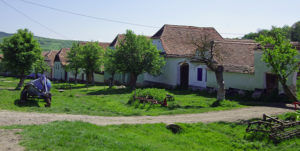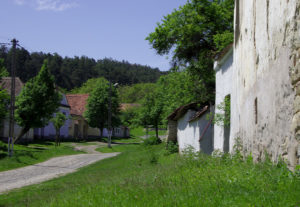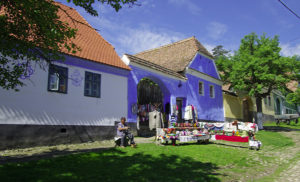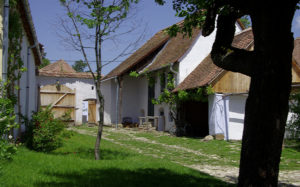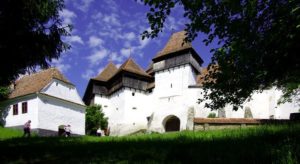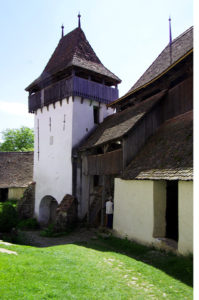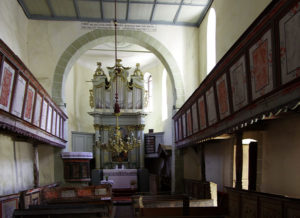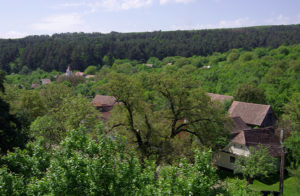Saxon culture in Transylvania dates back to 1153, when King Geza of hungary recruited mercenaries from the Mosel and Rhineland to guard his kingdom’s borders against attacks from the Turks and Tatars. In exchange he gave them fertile land, their own legal system and permanent rights of settlement and autonomy. Over the next eight centuries, the Saxons built their villages, kept their seclusion, intermarried and retained their own laws, religion, educational system and their arts and crafts.
Throughout Transylvania were small Saxon villages with fortified, frescoed churches, cobbled streets, stuccoed and gabled houses surrounded by fields, woods and valleys filled with wild flowers, rare birds and butterflies. Sheep grazed the pastures cared for by a shepherd with his dog and the family cow went out to graze at dawn and returned for milking each night.
“The Mihai Eminescu Trust”:https://www.mihaieminescutrust.ro/en/ was set up in 1987 in response to concerns that the Saxon culture of Transylvania was in danger of being lost. Ceauşescu had a policy of bulldozing old houses to replace them with concrete apartment blocks or factories as he wanted to transform Romania from an agricultural economy to an industrial based one.
After the fall of Ceauşescu, many of the Saxons living in Romania returned to Germany to live. Houses were boarded up and the fortified churches deserted. Romanians and Roma moved in. The few remaining Saxons were very worried about their loss of their way of life and cultural heritage.
The larger towns of Sibiu and Sighisoara have received support to restore their old towns, but little support was available for the villages. There was increasing concern that the old way of life would die out.
“Viscri”:http://wasleys.org.uk/eleanor/otherholidays/romania/day_four/four_three/index.html is the showcase village for the trust as part of the ‘Whole village Project’. This not only provides help to restore houses, barns and churches but also supports the villagers by reintroducing once thriving old crafts and skills like blacksmithing, weaving, knitting, basket making, painting and wood carving.
Villagers are taught traditional methods for restoring buildings, keeping as much of the original material as possible and local labour. Restored houses now provide food and accommodation for visitors. All the villagers, Romanians as well as the small number of Saxons, now see a future for themselves, their villages and their traditional way of life. The local economy is being revived through the renewal of its heritage and there is a sense of pride and a future.
Visiting Viscri is really like stepping back at least fifty years. It is reached five miles down a narrow rough road with a lot of potholes.
It is a very attractive village with a wide cobbled street with grassy verges and trees leading up to the church. Houses with their gates and yards have been carefully restored. Many are painted in the traditional deep blue colour which was supposed to keep flies away. Many of the houses do not have their own water supply and are dependent upon wells or pumps.
The yards contain barns, sheds and workshops. Geese and hens scratch for food outside the houses. Cows go out to graze during the day, returning to be milked every evening. The horse and cart is still the main means of travel.
Ladies sit outside the houses knitting socks and gloves which are sold from stalls lining the road to the church.
The C12th “church”:http://wasleys.org.uk/eleanor/otherholidays/romania/day_four/four_four/index.html s built on the highest point of the village and is one of the oldest churches in Transylvania. It was fortified in the C15th and withstood several Ottoman raids but was never occupied. The villagers retreated here in time of danger, only returning to their houses when the threat was over. A second outer wall with defensive towers was added in the C18th.
The church is at the centre of the walled enclosure. this has been carefully restored. “Inside,”:http://wasleys.org.uk/eleanor/otherholidays/romania/day_four/four_five/index.html a wooden gallery supported on rickety pillars runs round three sides of the walls. There are simple bench seats in the nave. The women sat at the front with the men behind and the boys sat right at the back of the church. The side benches with their painted panel fronts were reserved for wealthier members of the village. The Baroque reredos above the altar has picture of Christ blessing the children. Above this is the equally impressive Baroque organ.
The Trust is really making a difference to the people and economy of the area. The importance of its work is also recognised and supported by Prince Charles who was for many years its chairman and has set up “The Prince of Wales ’s Foundation Romania “:http://www.princeofwalescharitablefoundation.org.uk/about-us/our-initiatives/prince-waless-foundation-romania in Viscri to continue his work. He has made many visits to Romania and owns houses in the area including one in Viscri which is also a guest house for visitors to the village.
This is one of the few places that tourism has not destroyed what the tourists originally came to see. It s a delightful place.
I visited as part of a ten day trip to Romania. My full report with all my pictures is “here.”:http://wasleys.org.uk/eleanor/otherholidays/romania/index.html
